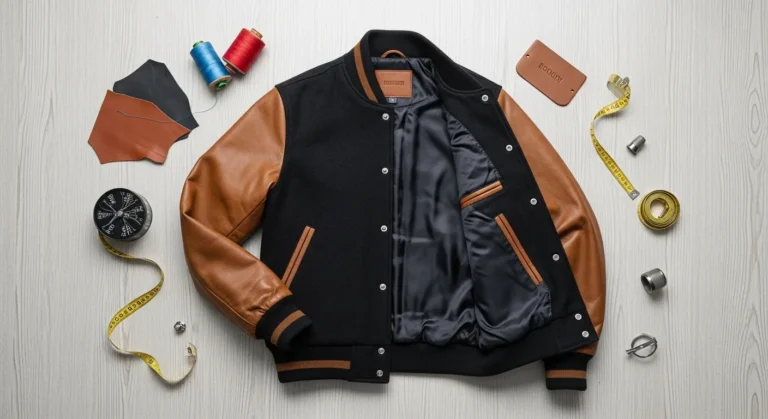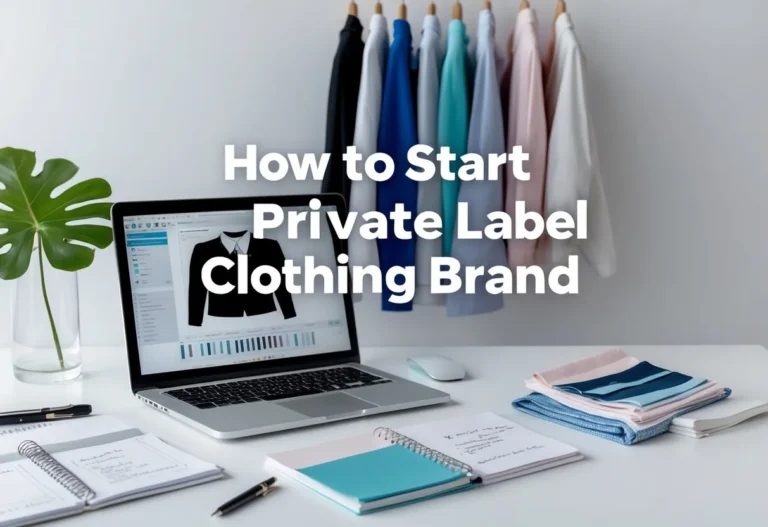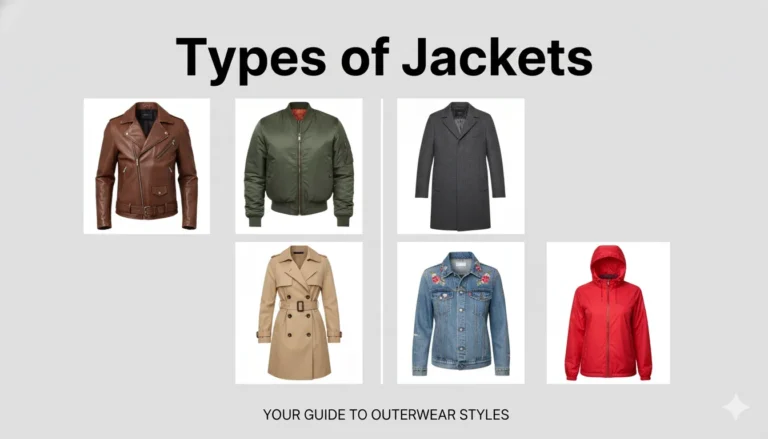Starting profitable loungewear business offers a unique chance to meet growing demand for comfortable, stylish clothing that fits modern lifestyles. Building a successful brand begins with defining a clear niche and creating designs that balance both comfort and fashion. This makes it easier to connect with the right customers and stand out in a competitive market.

Choosing quality materials, finding the right manufacturer, and carefully planning production are key steps in turning ideas into real products. With a strong brand identity and strategic marketing, a new loungewear business can quickly gain attention and grow. Understanding customer needs and market trends helps keep the business relevant and competitive.
Key Takeaways
- Identifying a clear market niche guides brand and product decisions.
- Quality design and production are essential for customer satisfaction.
- Effective marketing and customer focus drive business growth.
Defining Your Loungewear Brand Identity

A strong brand identity sets a clothing brand apart in a crowded market. It shapes how customers see the fashion brand and builds trust. This identity relies on clear messaging, knowing who the brand serves, and consistent visual style.
Identifying Your Unique Selling Proposition
The unique selling proposition (USP) is what makes the loungewear line special. It could be the choice of eco-friendly fabrics, affordable pricing, or cutting-edge designs. This USP must solve a specific problem or meet a particular need that current brands don’t fully address.
The USP guides product development and marketing messages. Highlighting it consistently helps the brand attract loyal customers. For example, a brand focusing on sustainable materials should emphasize ethical sourcing and fabric quality in all branding.
Choosing Your Target Audience
Defining the target audience means selecting the group most likely to buy the clothing brand’s loungewear. This can be based on age, lifestyle, values, or budget. Knowing the audience allows the brand to tailor products and marketing to their preferences.
A brand targeting busy professionals might design stylish yet comfortable pieces suitable for home and casual work settings. Meanwhile, a brand focused on wellness enthusiasts might prioritize organic fabrics and relaxed fits. Clear audience focus improves product appeal and marketing success.
Developing Your Brand Aesthetics
Brand aesthetics include the logo, color palette, fonts, and overall style. These visual elements communicate the brand’s personality and values instantly. The aesthetics must align with the USP and target audience to create a cohesive and memorable fashion brand.
A minimalist brand might use clean lines and neutral colors, while a fun, youthful brand could choose vibrant colors and playful fonts. Consistency across packaging, website, and social media strengthens recognition and builds customer loyalty.
Conducting Market Research and Trend Analysis

Market research and trend analysis help loungewear entrepreneurs make smart decisions. They learn what customers want, how competitors operate, and which trends will shape demand. This guidance allows businesses to create products that fit the market and avoid costly mistakes.
Analyzing Competitors in the Loungewear Market
Competitor analysis is key to understanding the landscape of the loungewear business. It involves looking closely at other brands’ pricing, styles, marketing strategies, and customer feedback. This helps identify what works and where gaps exist.
By studying top competitors, a brand can spot weaknesses to improve upon and strengths to match or beat. For example, if a competitor is missing plus-size options or sustainable materials, those gaps could become opportunities.
It’s also important to keep an eye on new entrants who might be shifting market share. Regular competitor analysis shapes product development and marketing to stay relevant amid growing competition.
Understanding Customer Preferences
Knowing who the customers are and what they want drives success in loungewear. Research methods like surveys, interviews, or social media listening reveal preferred fabrics, fits, colors, and price points.
Customer preferences also vary by age group, lifestyle, and values—such as comfort or eco-friendliness. For instance, younger buyers might prioritize sustainable materials, while others focus on versatility or affordability.
Clear knowledge of these preferences allows brands to tailor their product lines and messaging. Direct customer feedback reduces guesswork and improves product-market fit, which can boost sales and loyalty.
Staying Updated with Fashion Trends
Keeping up with fashion trends ensures a loungewear brand stays current. Trends can include colors, patterns, fabric technologies, or lifestyle shifts like the rise of remote work fueling demand for casual wear.
Trend analysis involves monitoring runway shows, industry reports, and consumer behavior. This helps predict what will grow or fade in popularity.
Adapting quickly to trends, such as offering breathable fabrics or bold prints, keeps the product line fresh. It also positions the brand as responsive, which appeals to trend-conscious consumers in a fast-moving fashion business.
Planning Your Loungewear Business

Planning a loungewear business requires clear goal-setting, choosing the right business model, and making sure the brand is legally registered. These steps form the foundation for launching a clothing line that can grow steadily and meet market needs.
Setting Business Goals and Objectives
Setting clear business goals gives direction to a loungewear brand. Goals should be specific, measurable, and realistic, such as launching a first collection within six months or achieving a set number of sales in the first year.
Objectives might include targeting a specific customer group, like eco-conscious buyers or plus-size markets. Defining goals helps in focusing design, marketing, and production efforts to meet these aims efficiently.
Goals also guide budgeting and resource allocation. For example, deciding whether to focus on online sales or retail partnerships shapes marketing and inventory strategies. Clear objectives reduce risks and keep the brand moving forward with purpose.
Choosing a Business Model
The choice of business model affects how a clothing brand operates and earns revenue. Common options include direct-to-consumer (DTC) online stores, wholesale partnerships with boutiques, or a hybrid approach combining both.
A DTC model offers control over branding and customer experience but requires investment in marketing and logistics. Wholesale can bring faster sales growth but involves dealing with retailer demands and lower profit margins.
Subscription boxes or limited-edition drops are other models that create exclusivity and repeat customers. Decision factors include initial funding, market reach, and long-term growth plans. The right model will align with the brand’s goals and target audience.
Registering Your Clothing Line
Registering the business legally is essential for operating a clothing brand. This starts with choosing the right business structure, such as a sole proprietorship, LLC, or corporation, each with different tax and liability implications.
Registering the brand name protects it from being used by others and can include trademarking the logo and slogan. This prevents legal issues and builds brand recognition.
The process usually involves registering with local or national government agencies, obtaining any required licenses, and meeting industry regulations. Proper registration ensures the brand can operate smoothly and build trust with customers and suppliers.
Designing and Developing Your Loungewear Collection

Designing and developing a loungewear collection requires clear ideas, detailed planning, and a focus on consistency. The process includes turning concepts into workable designs, creating technical documents and samples, and ensuring all pieces fit together as part of a single clothing brand.
Creating Your Design Concepts
The first step is to develop clear design concepts that fit the target market. A successful loungewear brand often focuses on comfort, fabric choice, and style that suits everyday wear at home. Designers should sketch or use software to create initial ideas, keeping in mind fabric types like cotton, bamboo, or modal for softness and breathability.
Color palettes and silhouettes need to align with the brand identity. For example, a fashion brand aimed at luxury customers might use muted tones and sleek shapes. Meanwhile, a casual clothing brand may focus on bright colors and relaxed fits. Mood boards help visualize the overall style and can include fabric swatches, color samples, and lifestyle images.
Preparing Tech Packs and Samples
Tech packs are crucial documents that detail every aspect of a design. They include measurements, fabric types, stitching instructions, trims, and any labels or tags needed. These must be clear and precise for manufacturers to produce accurate samples.
After creating tech packs, the next step is to produce samples. Samples allow the designer to check the quality and fit of the garment. This process often requires several rounds of adjustments. The goal is to ensure the final product matches the original design concept and meets comfort and durability standards.
Building a Cohesive Collection
A clothing brand’s success depends on how well its pieces work together. To build a cohesive collection, each item should complement the others in style, color, and fabric. This balance helps shoppers create complete outfits, increasing the chances of multiple purchases.
It’s important to offer variety without straying too far from the core brand identity. For example, a collection might consist of matching tops and bottoms, robes, and accessories like slippers or headbands. Keeping a consistent theme and quality across all items helps establish a strong fashion brand that customers recognize and trust.
Sourcing Materials and Managing Production

Sourcing the right materials and managing production are critical steps in creating a loungewear brand. It requires finding dependable fabric suppliers, choosing manufacturers who can meet quality and delivery demands, and keeping sustainability in mind to appeal to today’s consumers.
Finding Reliable Fabric Suppliers
Finding trustworthy fabric suppliers is essential to ensure material quality and consistent supply. Designers should look for suppliers that provide detailed information on fabric composition, certifications, and minimum order quantities. Sampling fabrics before bulk orders helps verify softness, durability, and color fastness, which are vital for loungewear comfort.
Suppliers specializing in natural fibers like cotton, bamboo, or sustainable blends add value as these align with growing eco-conscious customer preferences. Clear communication about pricing, lead times, and return policies is necessary to avoid issues. Local suppliers can reduce shipping times and costs but international options may offer more variety or better pricing.
Evaluating Factories and Manufacturers
Selecting the right factory or manufacturer involves assessing their experience with loungewear production, capacity, and quality control processes. A factory must be able to handle order sizes and deliver on time. Reviewing samples and visiting facilities, if possible, provides insight into workmanship and operational standards.
Manufacturers offering flexibility in fabric customization, sizes, and prints allow brands to maintain uniqueness. Contracts should outline production timelines, cost per unit, and penalties for delays. Location matters; local manufacturers may ease communication, while overseas factories might reduce costs but require careful management of logistics and quality checks.
Ensuring Product Quality and Sustainability
Maintaining product quality throughout production ensures customers receive durable, comfortable loungewear. Brands should implement quality checks at each stage, from fabric inspection to final garment finishing. This includes testing seam strength, stitching consistency, and fabric feel.
Sustainability is increasingly important. Choosing eco-friendly fabrics and ethical factories that pay fair wages and minimize waste can improve brand reputation. Certifications like GOTS (Global Organic Textile Standard) or OEKO-TEX help verify sustainable claims. Incorporating these practices supports long-term brand trust and aligns with market demand for responsible fashion.
Launching and Marketing Your Loungewear Brand

Launching a loungewear brand requires precise preparation and thoughtful marketing. Key elements include creating strong brand visuals, planning targeted marketing efforts, and building a user-friendly online store that converts visitors into customers.
Developing Your Brand Assets
Brand assets are the visual and verbal tools that make a clothing brand recognizable. These include the logo, color palette, typography, and packaging design. Consistency across all brand assets helps establish a professional and memorable identity.
The brand name should be simple and reflect the style and values of the loungewear line. Creating a clear brand voice that highlights comfort, sustainability, or luxury can connect with the target audience emotionally.
Packaging should also reinforce brand values. For example, eco-friendly materials support a sustainable fashion business image. All elements together create a cohesive look that customers remember.
Creating a Marketing Strategy
A strong marketing strategy focuses on reaching the ideal customers and building long-term engagement. It often combines social media advertising, influencer collaborations, and content marketing.
Using social media platforms like Instagram or TikTok allows direct connection with consumers who prioritize style and comfort. Sponsored posts and giveaways with influencers help increase brand visibility.
Email marketing is important for retaining customers and encouraging repeat purchases. Targeted emails with discounts, new product launches, or styling tips keep the audience engaged and informed.
Paid ads should be optimized by targeting demographics interested in loungewear, such as remote workers or athleisure fans. A clear budget and set goals help measure success regularly.
Building an Online Storefront
An effective online store is crucial for a clothing brand’s sales and growth. The website should be easy to navigate, mobile-friendly, and fast-loading to provide a smooth shopping experience.
High-quality images showing the loungewear worn in everyday settings help customers visualize the product. Product descriptions must be clear, highlighting fabric quality, fit, and style.
The store should offer secure payment options and transparent shipping policies to build trust. Features like customer reviews or size guides further assist customers with their purchase decisions.
Integrating inventory management tools helps track stock levels and avoid overselling. The online storefront is the main sales channel and must represent the brand fully and professionally.
Managing Growth and Scaling Your Loungewear Business

Growing a loungewear brand requires careful planning in operations, product development, and customer engagement. Efficient management of supply chains, introducing new products, and keeping customers loyal are critical for long-term success.
Optimizing Operations and Logistics
To handle growth, the business must refine its supply chain and production processes. Finding a manufacturer that can scale production while maintaining quality is key. It’s important to negotiate flexible minimum order quantities (MOQs) to avoid excess inventory.
Efficient inventory management software helps track stock levels and sales trends. Streamlining order fulfillment with reliable shipping partners ensures timely delivery, which improves customer satisfaction.
Automation tools can reduce manual tasks in warehousing and customer communication. Monitoring lead times and production schedules regularly helps avoid delays and keeps launches on track.
Expanding Product Lines
Introducing new product styles can widen the customer base and boost sales. Brands should analyze customer feedback and market trends to decide which pieces to add, such as joggers, robes, or sleepwear.
Offering variations in fabric and size increases appeal. For example, eco-friendly materials or plus size options can fulfill unmet demands.
Careful planning is necessary to maintain brand identity while diversifying. Testing new items with limited runs or pre-orders minimizes risk and helps gauge demand before full production.
Building Customer Loyalty
Creating loyal customers reduces marketing costs and fosters repeat business. Brands can implement loyalty programs that reward repeat purchases with discounts or early access to new collections.
Personalized email marketing, based on past purchases, keeps customers engaged. Providing excellent customer service builds trust and positive brand reputation.
Social media communities and influencer partnerships encourage customers to become brand advocates. Consistent communication and listening to customer needs deepen brand connection and retention.
Frequently Asked Questions
What are the initial steps to take when starting a loungewear business?
The first step is to define the niche and target audience. Then, create a clear brand identity that stands out. Designing the collection follows, focusing on comfort and style. Finally, find a reliable manufacturer to produce samples for testing before full production.
How can I identify and define my target market for a loungewear line?
Research current market trends and customer needs. Look at lifestyle, shopping habits, and preferences. Narrow the audience by factors like age, gender, and interests, such as eco-friendly products or plus-size options. Competitive analysis helps to find gaps and opportunities.
What are the key considerations for choosing a supplier or manufacturer for loungewear?
Check their experience with loungewear, minimum order quantities, sample support, and fabric sourcing. Certifications like OEKO-TEX or GOTS matter for quality and sustainability. Ask about lead times, production flexibility, and quality control to ensure smooth cooperation.
What are effective marketing strategies for a new loungewear brand?
Build a strong online presence with a user-friendly website and active social media. Use professional photos and clear descriptions. Collaborate with influencers whose followers match the target market. Use email marketing, paid ads, and SEO to attract and keep customers.
How much capital is required to launch a loungewear business?
Startup costs vary but generally include design, sampling, manufacturing, marketing, and platform setup. Loungewear businesses often have lower initial costs compared to other fashion sectors. Budget for flexibility in production volumes to test the market with minimal risk.
What legal and regulatory aspects must be considered when opening a loungewear business?
Register the business legally and choose a proper structure such as LLC or sole proprietorship. Protect the brand name with trademarks. Comply with labeling, safety, and environmental regulations specific to clothing. Keep documents for taxes, contracts, and supplier agreements organized.






